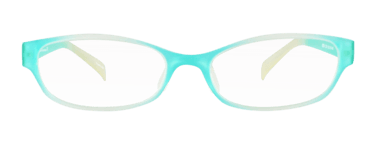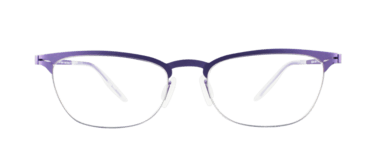Anti-Reflective Lenses
Anti-reflective lenses: you've probably heard the term at your optician's office, or seen it floating around our website. But what exactly are anti-reflective lenses?
Basically, anti-reflective lenses are lenses, no matter what the material, that are treated with a super thin coating consisting of multiple layers that virtually eliminates reflections. This coating is called an anti-reflective (AR) coating, and enables all available light to pass through the lens material. This way, you will be free of annoying reflections on the back of your lens, increasing your visual acuity, and others can see you clearly because reflections off the front of your lens are also a thing of the past. So, simply stated, AR coatings have two major benefits: increased visual acuity and cosmetic appeal.
| Lens Material | Index | Without AR | With AR |
| CR-39 | 1.50 | 92.06% | 99.1% |
| Polycarbonate | 1.58 | 89.4% | 99.0% |
| High Index | 1.61 | 89.4% | 99.0% |
| Extra High Index | 1.67 | 87.8% | 98.2% |
Visual Acuity
Standard plastic lenses of CR-39 material allow only about 92% of light to pass through. This means that 8% of light is reflected, both off the front and the back of the lens. Reduced light transmission will give the lenses a very dull and grayish appearance, and annoying reflections from the back of the lens can interfere with the clarity of your vision, which can be downright dangerous especially while driving. Additionally, these reflections only get worse as lens index increases (see table), making an AR coating increasingly important.
Cosmetic Appeal
Have you ever seen a picture of yourself with glasses on where you're unable to see your eyes because of unsightly reflections? Lenses without AR coating reflect much more light, making it hard to see your eyes and hindering your cosmetic appeal. Recent studies show that the average person thinks it's important for people to see their eyes when communicating. AR coatings help you look more natural, and help other people feel more comfortable when communicating with you.
Workings of AR
Let's explain how AR coatings work, without getting too scientific. The basic concept behind AR treatment is the "optical interference model." Each layer of the coating introduces opposite waves of light. Combined with the previous layers in the coating stack, these opposite waves work together to cancel out a broad range of light waves. In this way, the reflective properties of that range of light are cancelled.
 |
Lens without AR: Visible reflections on both the front and back of uncoated lenses cause a reduction of light transmission by up to 15% of available light. As the index of lens material increases, reflections and glare increase as well. |
|
|
Optical Interference Model AR coating layers work together to create opposing waves of light that are half a wave out of phase, which cancel out reflections. |
|
This model is extremely simplified. Please understand that the way an AR coating works is much more complicated than this, due to its multi-layer structure that eliminates reflections across the entire light spectrum. |
|
Now that we've explained the basics of AR to you, let's answer a few questions we get asked rather often.
How come AR coated lenses get dirty more easily than uncoated lenses?
Honestly, they don't. People may think this because the reflections on uncoated lenses hide the dirt for longer. Due to the increased clarity of AR lenses, dirt is more easily visible. A person wearing uncoated lenses may have their vision hindered for an entire day without noticing, but AR coated lenses make it clear quickly that visual acuity is not optimal. AR lenses are cleaned more often, resulting in improved (and safer) vision. And, best of all, modern AR coatings are very easy to clean compared to the first generations.
Why do some AR coatings have a different colored reflection than others?
First, let us point out that AR coated lenses only give off a small amount of reflection when held at a certain angle. This is a normal occurance linked with the reflectance curve of a broad band AR coating across the entire visible light spectrum. At some point, the coating has a peak reflectance, and that is the color that is reflected more than any other color on the spectrum. Frequently, this reflection color is of a green or purple hue.
An AR coating is an important part of your glasses, which is why Visio-Rx includes it on every single lens without extra charges. If you have any more questions about AR lenses, please contact us via chat or email. ![]()
Recommended for you













